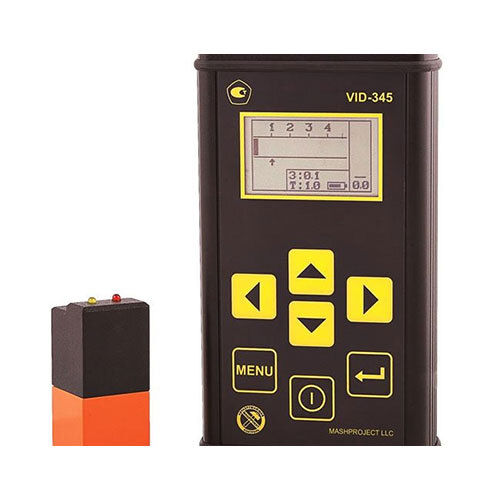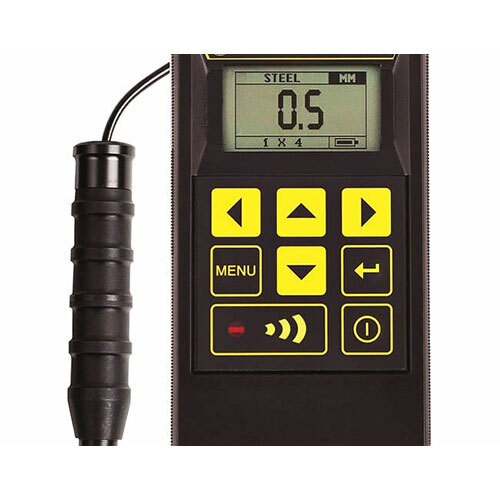Magnetic Eddy Current Flaw Detector
Product Details:
- Operating Voltage 3.7V (Battery)
- Temperature 0C to 50C
- Humidity 85% RH
- Material Plastic
- Mounting Type Handheld
- Resolution 0.001 mm
- Port Size Standard
- Click to View more
X
Magnetic Eddy Current Flaw Detector Price And Quantity
- 1 Piece
Magnetic Eddy Current Flaw Detector Product Specifications
- Standard
- 0-1000 mm
- 1 Second
- Battery Operated
- 0C to 50C
- Up to 500 mm/s
- 3.7V (Battery)
- 85% RH
- Handheld
- Automatic / Manual
- Plastic
- 0.001 mm
- Up to 10 tests/min
- 0.02 mm
- Industrial
- Portable, High Sensitivity, Lightweight
- Digital LCD
- Magnetic Eddy Current Flaw Detector
- 10 mm to 150 mm diameter
- 0.1 mm to 10 mm
- 0.01 mm5 mm
- Crack/Flaw Detection in Metal components
- Semi-automatic
- Black
- 150 mm
- 1 at a time
- 2.5 kg
- 200 mm
- 100 kHz to 10 MHz
- USB, RS232
Magnetic Eddy Current Flaw Detector Trade Information
- 7-10 Days
Product Description
A magnetic eddy current flaw detector is a non-destructive testing (NDT) instrument used to detect surface and near-surface flaws in conductive materials. It operates based on the principles of electromagnetic induction.
Heres how it generally works:
1. Generation of Magnetic Field: The device generates a magnetic field around the material being tested. This magnetic field induces eddy currents within the conductive material.
2. Eddy Currents Interaction: When the magnetic field encounters a flaw or defect in the material, the eddy currents are disrupted or distorted. This distortion is due to changes in the electrical conductivity or magnetic permeability caused by the presence of the flaw.
3. Detection of Disturbances: Sensors in the flaw detector detect these disturbances in the eddy currents. Changes in the amplitude, phase, or frequency of the eddy currents can indicate the presence and characteristics of a flaw.
4. Data Analysis: The signals detected by the sensors are processed and analyzed by the instruments electronics. This analysis can provide information about the location, size, shape, and orientation of the flaw.
5. Display and Interpretation: The results are typically displayed on a screen or through other output methods. Trained operators interpret these results to determine the significance of any detected flaws and whether further investigation or corrective action is needed.
Magnetic Eddy Current Flaw Detector Applications:
1. Aerospace Industry: Magnetic eddy current flaw detectors are used to inspect aircraft components such as turbine blades, engine parts, landing gear, and fuselage structures for cracks, corrosion, and other defects. Ensuring the integrity of these components is vital for aviation safety.
2. Automotive Industry: In automotive manufacturing, these flaw detectors are employed to inspect critical components like engine blocks, cylinder heads, suspension parts, and drivetrain components for defects that could compromise performance or safety.
3. Railway Industry: Magnetic eddy current testing is utilized to inspect railway tracks, wheels, axles, and other components for defects such as cracks, wear, and material degradation. Detecting flaws early helps prevent accidents and ensures the reliability of railway infrastructure.
4. Petrochemical Industry: Pipelines, storage tanks, and pressure vessels in the petrochemical industry are subject to corrosion, erosion, and other forms of degradation over time. Eddy current testing is used to assess the integrity of these assets without the need for invasive inspections.
5. Power Generation: Turbine blades, generators, and other components in power generation plants are subjected to harsh operating conditions and high stress. Flaw detection using eddy current testing helps identify defects early, minimizing the risk of failures and downtime.
6. Manufacturing and Fabrication: Magnetic eddy current flaw detectors are integrated into manufacturing processes to inspect welds, castings, forgings, and other fabricated components for defects such as cracks, porosity, and incomplete fusion.
7. Structural Inspection: Eddy current testing is used to assess the structural integrity of bridges, buildings, pipelines, and other infrastructure assets. It helps identify corrosion, fatigue cracks, and other defects that could compromise safety and performance.
8. Material Sorting and Quality Control: In material processing industries like steel production, eddy current testing is used for sorting and quality control purposes. It helps identify and segregate materials with defects or inconsistencies in their composition.
Advanced Detection Capabilities
This flaw detector uses eddy current technology to accurately identify cracks or imperfections in metal components. High sensitivity and a wide measuring range (0.01 mm5 mm) ensure reliable results across diverse applications, offering confidence for quality assurance in industrial environments.
User-Friendly Operation and Storage
With both automatic and manual control modes, users can choose settings tailored to specific requirements. Its digital LCD, audio/visual alarms, and quick response time (1 second) streamline real-time analysis, while internal memory for up to 1,000 records simplifies data management for ongoing testing projects.
Portability and Versatile Application
Weighing just 2.5 kg and featuring a durable plastic body, the handheld design supports flexible on-site testing. The detectors USB and RS232 interfaces enable easy data transfer, making it suitable for manufacturers, suppliers, and field service providers looking for efficiency and portability.
FAQs of Magnetic Eddy Current Flaw Detector:
Q: How does the Magnetic Eddy Current Flaw Detector identify defects in metal components?
A: This detector employs an eddy current probe, generating electromagnetic fields to detect disruptions caused by cracks or other flaws in conductive materials. Any irregularity changes the eddy current response, which the device picks up and signals through its audio/visual alarms.Q: What is the process for calibrating the flaw detector?
A: Calibration can be performed either automatically or manually, ensuring precise measurements. The user simply follows the on-screen digital LCD prompts or uses reference standards provided by the manufacturer, aligning the device for accurate flaw detection tasks.Q: Where can this flaw detector be effectively used?
A: It is ideally suited for industrial environments, including manufacturing plants, metal processing facilities, and quality assurance labs in India and abroad. The devices portable, battery-powered design allows for both in-house and on-site inspections.Q: What types of metal specimens can be tested, and what are the size requirements?
A: The detector accepts single specimens at a time, with acceptable diameters ranging from 10 mm to 150 mm and test strokes up to 1,000 mm. Its suitable for components within a max height of 200 mm and a test width of 150 mm.Q: How is test data stored and accessed with this device?
A: Results from up to 1,000 tests can be stored in the internal memory. Data can be transferred via USB or RS232 interface for further analysis or reporting, supporting efficient data management and traceability.Q: What are the benefits of using this flaw detector in industrial applications?
A: Users benefit from high detection sensitivity, rapid test speeds (up to 10 tests per minute), digital accuracy (0.02 mm), and reliable performance within varied temperatures and humidity levelsmaking it an excellent choice for modern quality assurance.Tell us about your requirement

Price:
Quantity
Select Unit
- 50
- 100
- 200
- 250
- 500
- 1000+
Additional detail
Mobile number
Email
 English
English Spanish
Spanish French
French German
German Italian
Italian Chinese (Simplified)
Chinese (Simplified) Japanese
Japanese Korean
Korean Arabic
Arabic Portuguese
Portuguese



 Call Me Free
Call Me Free
